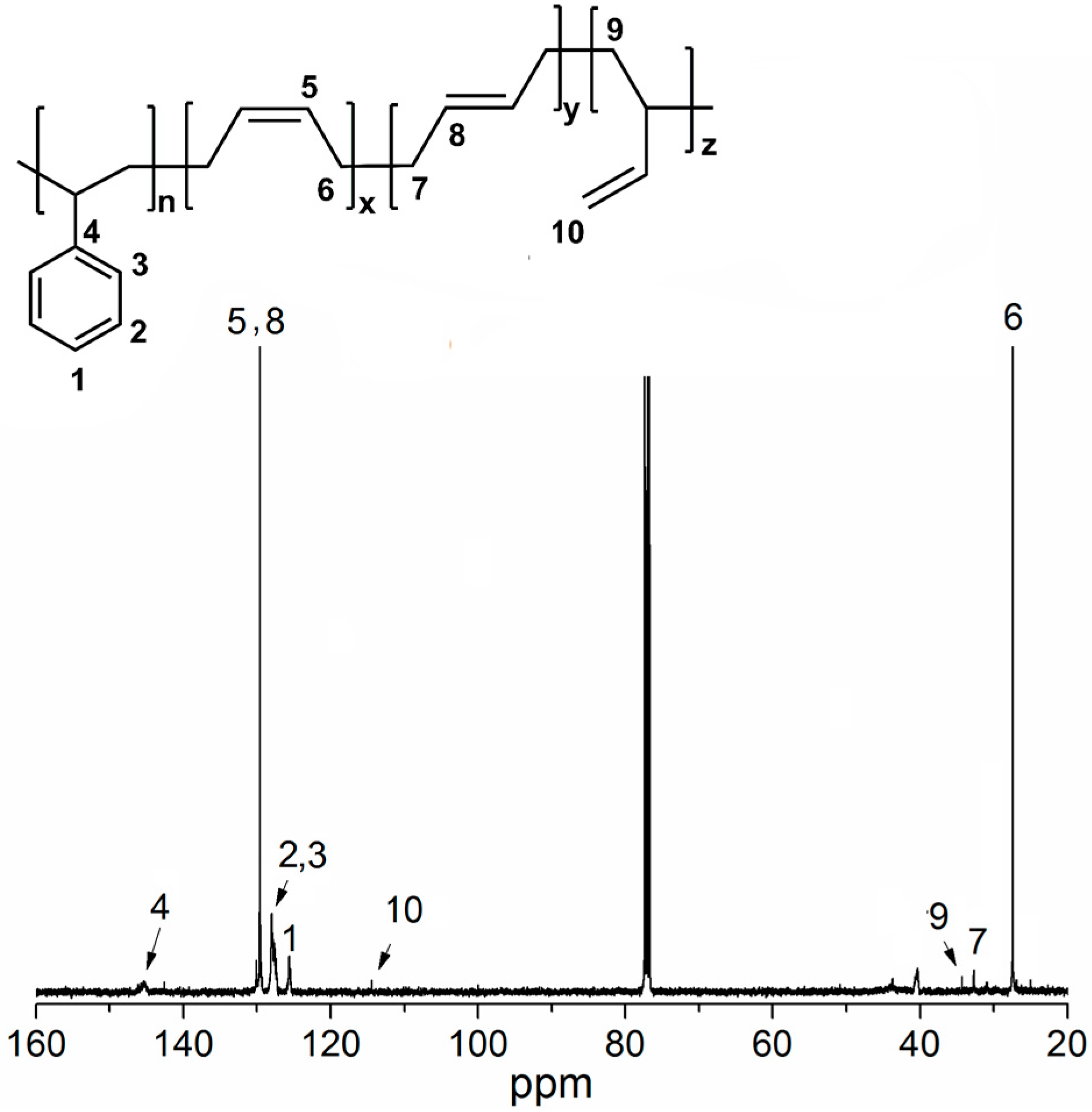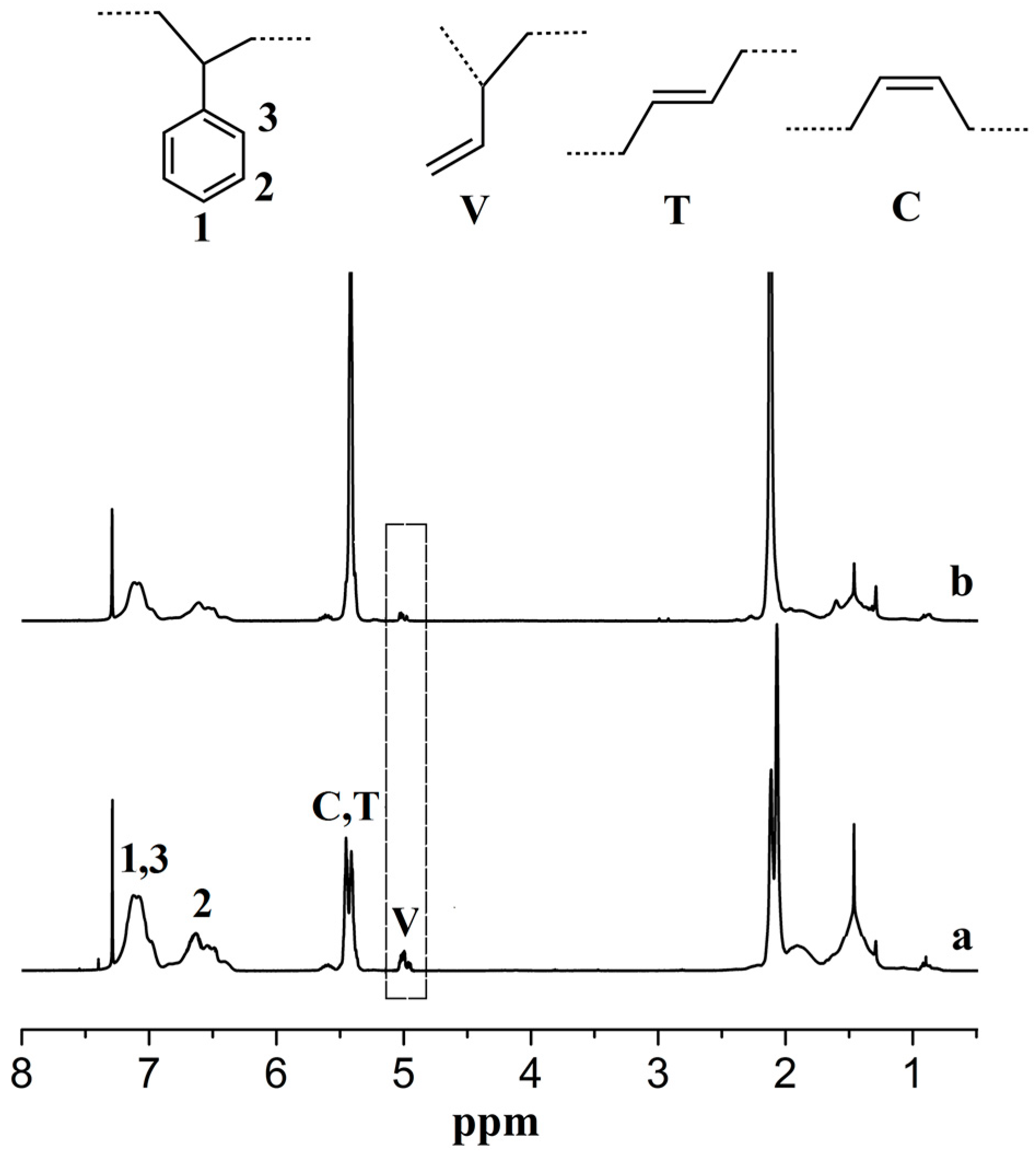A New Synthesis Strategy on Styrene-Butadiene Di-Block Copolymer Containing High cis-1,4 Unit Via Transfer of Anionic to Coordination Polymerization
Abstract
:1. Introduction
2. Experimental
2.1. Materials
2.2. Synthesis of PS-b-PB via Ni/PSLi/B Catalyst System
2.3. Synthesis PS-b-PB via n-Butyllithium Catalyst System
2.4. Homopolymerization of Butadiene
2.5. Molecular Structure Characterizations
3. Results and Discussion
3.1. Confirmation of Resulted Copolymer Structures
3.2. Comparison of Ni/PSLi/B and n-Butyllithium Catalyst Systems
3.3. The Determination of the Ratio of [Li]/[Ni] and [B]/[Li]
3.4. The Effect of the Monomer Feed Ratio of [Bd]/[St] on the Structure of PS-b-PB
4. Conclusions
Author Contributions
Funding
Acknowledgments
Conflicts of Interest
References
- Oehme, A.; Gebauer, U.; Gehrke, K.; Lechner, M.D. Copolymerization of 1,3-butadiene and styrene with a neodymium catalys. Macromol. Rapid. Commun. 1995, 16, 563–569. [Google Scholar] [CrossRef]
- Vasilenko, I.V.; Yeong, H.Y.; Delgado, M.; Ouardad, S.; Peruch, F.; Voit, B.; Ganachaud, F.; Kostjuk, S.A. Catalyst Platform for Unique Cationic (Co)Polymerization in Aqueous Emulsion. Angew. Chem. Int. Ed. 2015, 54, 12728–12732. [Google Scholar] [CrossRef] [PubMed]
- Lee, I.; Bates, F.S. Synthesis, Structure, and Properties of Alternating and Random Poly(styrene-b-butadiene) Multiblock Copolymers. Macromolecules 2013, 46, 4529–4539. [Google Scholar] [CrossRef]
- Jian, Z.B.; Tang, S.; Cui, D.M. Highly Regio- and Stereoselective Terpolymerization of Styrene, Isoprene and Butadiene with Lutetium-Based Coordination Catalyst. Macromolecules 2011, 44, 7675–7681. [Google Scholar] [CrossRef]
- Caprio, M.; Serra, M.C.; Bowen, D.E.; Grassi, A. Structural Characterization of Novel Styrene−Butadiene Block Copolymers Containing Syndiotactic Styrene Homosequences. Macromolecules 2002, 35, 9315–9322. [Google Scholar] [CrossRef]
- Bielawski, C.W.; Morita, T.; Grubbs, R.H. Synthesis of ABA Triblock Copolymers via a Tandem Ring-Opening Metathesis Polymerization: Atom Transfer Radical Polymerization Approach. Macromolecules 2000, 33, 678–680. [Google Scholar] [CrossRef]
- Wei, R.Z.; Luo, Y.W.; Wang, Z.; Xu, F.Z.; Wei, S.H. Styrene–Butadiene–Styrene Triblock Copolymer Latex via Reversible Addition–Fragmentation Chain Transfer Miniemulsion Polymerization. Ind. Eng. Chem. Res. 2012, 51, 15530–15535. [Google Scholar] [CrossRef]
- Lanzi, M.; Paganin, L.; Di-Nicola, F.P.; Trombini, C. Effects of polar additives on the anionic polymerization of 1,3-butadiene and styrene. J. Polym. Res. 2015, 22, 208. [Google Scholar] [CrossRef]
- Wang, X.B.; Kang, X.H.; Zhou, G.L.; Qu, J.P.; Hou, Z.M.; Luo, Y. DFT Studies on cis-1,4-Polymerization of Dienes Catalyzed by a Cationic Rare-Earth Metal Complex Bearing an Ancillary PNP Ligand. Polymers 2017, 9, 53. [Google Scholar] [CrossRef]
- Jian, Z.B.; Tang, S.; Cui, D.M. A Lutetium Allyl Complex That Bears a Pyridyl-Functionalized Cyclopentadienyl Ligand: Dual Catalysis on Highly Syndiospecific and cis-1,4-Selective (Co)Polymerizations of Styrene and Butadiene. Chem-Eur. J. 2010, 16, 14007–14015. [Google Scholar] [CrossRef]
- Zhang, W.B.; Zhang, G.H.; Du, L.; Zhang, C.; Li, L.; Zhu, J.F.; Pei, J.; Wu, J. Synthesis of hydroxyl-terminated polybutadiene bearing pendant carboxyl groups by combination of anionic polymerization and blue light photocatalytic thiol-ene reaction and its pH-triggered self-assemble behavior. React. Funct. Polym. 2018, 127, 161–167. [Google Scholar] [CrossRef]
- Ren, C.Y.; Li, G.L.; Dong, W.M.; Jiang, L.S.; Zhang, X.Q.; Wang, F.S. Soluble neodymium chloride 2-ethylhexanol complex as a highly active catalyst for controlled isoprene polymerization. Polymer 2007, 48, 2470–2473. [Google Scholar] [CrossRef]
- Zhang, L.X.; Suzuki, T.; Luo, Y.; Nishiura, M.; Hou, Z.M. Cationic Alkyl Rare-Earth Metal Complexes Bearing an Ancillary Bis(phosphinophenyl)amido Ligand: ACatalytic System for Living cis-1,4-Polymerization and Copolymerization of Isoprene and Butadiene. Angew. Chem. Int. Ed. 2007, 119, 1909–1913. [Google Scholar] [CrossRef] [PubMed]
- Dai, Q.Q.; Zhang, X.Q.; Hu, Y.M.; He, J.Y.; Shi, C.; Li, Y.Q.; Bai, C.X. Regulation of the cis-1,4- and trans-1,4-Polybutadiene Multiblock Copolymers via Chain Shuttling Polymerization Using a Ternary Neodymium Organic Sulfonate Catalyst. Macromolecules 2017, 50, 7887. [Google Scholar] [CrossRef]
- Wang, J.; Wu, Y.X.; Xu, X.; Zhu, H.; Wu, G.Y. An activated neodymium-based catalyst for styrene polymerization. Polym. Int. 2005, 54, 1320–1325. [Google Scholar] [CrossRef]
- Schellenberg, J. Recent transition metal catalysts for syndiotactic polystyrene. Prog. Polym. Sci. 2009, 34, 688–718. [Google Scholar] [CrossRef]
- Jiang, L.M.; Shen, Z.Q.; Yang, Y.H.; Zhang, Y.F. Synthesis of ultra-high molecular weight polystyrene with rare earth–magnesium alkyl catalyst system: General features of bulk polymerization. Polym. Int. 2001, 50, 63–66. [Google Scholar] [CrossRef]
- Zhang, Q.S.; Li, W.S.; Shen, Z.Q. Copolymerization of butadiene and styrene with neodymium naphthenate based catalyst. Eur. Polym. J. 2002, 38, 869–873. [Google Scholar] [CrossRef]
- Zhu, H.; Wu, Y.X.; Zhao, J.W.; Guo, Q.L.; Huang, Q.G.; Wu, G.Y. Styrene-butadiene block copolymer with high cis-1,4 microstructure. J. Appl. Polym. Sci. 2007, 106, 103–109. [Google Scholar] [CrossRef]
- Zambelli, A.; Proto, A.; Longo, P.; Oliva, P. Binary copolymerizations of styrene and conjugated diolefins in the presence of cyclopentadienyltitanium trichloride-methylaluminoxane. Macromol. Chem. Phys. 1994, 195, 2623–2631. [Google Scholar] [CrossRef]
- Ban, H.T.; Kase, T.; Kawabe, M.; Miyazawa, A.; Ishihara, T.; Hagihara, H.; Tsunogae, Y.; Murata, M.; Shiono, T. A New Approach to Styrenic Thermoplastic Elastomers: Synthesis and Characterization of Crystalline Styrene-Butadiene-Styrene Triblock Copolymers. Macromolecules 2006, 39, 171–176. [Google Scholar] [CrossRef]
- Li, P.; Zhang, K.Y.; Nishiura, M.; Hou, Z.M. Chain-Shuttling Polymerization at Two Different Scandium Sites: Regio- and Stereospecific “One-Pot” Block Copolymerization of Styrene, Isoprene, and Butadiene. Angew. Chem. Int. Ed. 2011, 50, 12012–12015. [Google Scholar]
- Kaita, S.; Hou, Z.M.; Wakatsuki, Y. Random- and Block-Copolymerization of 1,3-Butadiene with Styrene Based on the Stereospecific Living System: (C5Me5)2Sm(μ-Me2)AlMe2/[Ph3C][B(C6F5)4][1]. Macromolecules 2001, 34, 1539–1541. [Google Scholar] [CrossRef]
- Dixon, C.; Duck, E.W.; Grieve, D.P.; Jenkins, D.K.; Thornber, M.N. High cis-1,4 polybutadiene synthesis-ⅠThe catalystsystem nickel diisopropyl salicylate, boron trifluoride ether, butyllithium. Eur. Polym. J. 1971, 7, 55–63. [Google Scholar]
- Taube, R.; Windisch, H.; Maiwald, S. The catalysis of the stereospecific butadiene polymerization by Allyl Nickel and Allyl Lanthanide complexes—A mechanistic comparison. Macromol. Symp. 1995, 89, 393–409. [Google Scholar] [CrossRef]
- Throckmorton, M.C.; Farson, F.S. An HF-Nickel-R3Al Catalyst System for Producing High cis-1,4-Polybutadiene. Rubber Chem. Technol. 1972, 45, 268–277. [Google Scholar] [CrossRef]
- Ricci, G.; Sommazzi, A.; Masi, F.; Ricci, M.; Boglia, A.; Leone, G. Well-defined transition metal complexes with phosphorus and nitrogen ligands for 1,3-dienes polymerization. Coordin. Chem. Rev. 2010, 254, 661–676. [Google Scholar] [CrossRef]










| Entry | Sample | Conv d % | St cont e mol % | Mn f *104 g/mol | Mw/Mn f | cis-1,4 g % | trans-1,4 g % | 1,2- g % |
|---|---|---|---|---|---|---|---|---|
| 1 | PS-b-PB-4 a | 91.8 | 25.8 | 8.3 | 1.29 | 97.1 | 0.6 | 2.3 |
| 2 | PS-b-PB-a b | 67.2 | 33.9 | 6.2 | 1.16 | 48.9 | 39.8 | 11.3 |
| 3 | PB-1 c | 87.6 | 0 | 4.9 | 1.85 | 96.7 | 0.8 | 2.5 |
| Sample | [Bd]/[St] mol/mol | xSt b mol % | Mn c *104 g/mol | Mw/Mn c | cis-1,4 d % | trans-1,4 d % | 1,2- d % |
|---|---|---|---|---|---|---|---|
| PS-b-PB-1 | 0.25 | 65.7 | 4.1 | 1.41 | 96.8 | 0.8 | 2.4 |
| PS-b-PB-2 | 0.5 | 46.8 | 5.5 | 1.30 | 97.0 | 0.7 | 2.3 |
| PS-b-PB-3 | 0.75 | 34.5 | 6.8 | 1.32 | 97.1 | 0.7 | 2.2 |
| PS-b-PB-4 | 1.0 | 25.8 | 8.3 | 1.29 | 97.1 | 0.6 | 2.3 |
| PS-b-PB-5 | 1.5 | 20.2 | 11.2 | 1.31 | 97.3 | 0.5 | 2.2 |
| PS-b-PB-6 | 2.0 | 11.8 | 13.8 | 1.38 | 97.2 | 0.6 | 2.2 |
© 2019 by the authors. Licensee MDPI, Basel, Switzerland. This article is an open access article distributed under the terms and conditions of the Creative Commons Attribution (CC BY) license (http://creativecommons.org/licenses/by/4.0/).
Share and Cite
Liu, J.; Min, X.; Zhu, X.; Wang, Z.; Wang, T.; Fan, X. A New Synthesis Strategy on Styrene-Butadiene Di-Block Copolymer Containing High cis-1,4 Unit Via Transfer of Anionic to Coordination Polymerization. Polymers 2019, 11, 195. https://doi.org/10.3390/polym11020195
Liu J, Min X, Zhu X, Wang Z, Wang T, Fan X. A New Synthesis Strategy on Styrene-Butadiene Di-Block Copolymer Containing High cis-1,4 Unit Via Transfer of Anionic to Coordination Polymerization. Polymers. 2019; 11(2):195. https://doi.org/10.3390/polym11020195
Chicago/Turabian StyleLiu, Jie, Xin Min, Xiuzhong Zhu, Zichao Wang, Tong Wang, and Xiaodong Fan. 2019. "A New Synthesis Strategy on Styrene-Butadiene Di-Block Copolymer Containing High cis-1,4 Unit Via Transfer of Anionic to Coordination Polymerization" Polymers 11, no. 2: 195. https://doi.org/10.3390/polym11020195





